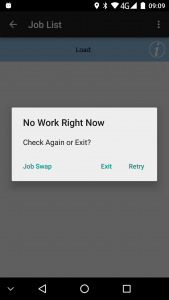PDA New Loads: Difference between revisions
m (Remove Windows reference) |
(Update for app version 3.3.2.0) |
||
| Line 1: | Line 1: | ||
==Retrieving New Loads== | ==Retrieving New Loads== | ||
Loads are assigned by the system by using the user and vehicle that was used when logging on to the mobile device application. | |||
Loads cannot be picked by the user on the device - the system allocates workloads to a user based how they have been allocated on the system, in this sequence: | |||
* If pending loads are found that match the user and vehicle exactly, the earliest of these loads is sent to the device. | |||
* If pending loads are found that are allocated to the user, with no explicit vehicle assigned to the load, the earliest of these loads is displayed on the device, and the load is assigned to the vehicle selected by the user when started. | |||
* If pending loads are found that are allocation to the vehicle, with no explicit user assigned to the load, the earliest of these loads is displayed on the device, and the load is assigned to the user when started. | |||
If no workload is found, the user will be advised, and will be given the option to retry. If '''No''' is clicked, the application will shut down. | |||
== Completing Loads == | |||
If all jobs on a workload are completed, when returned to the job menu a prompt will be displayed, asking whether a new load should be retrieved. If '''Yes''' is selected, the application will attempt to retrieve the next load available assigned. If it is retrieved successfully, the jobs will be displayed within the Job List. If this is unsuccessful, the user will be advised, and will be given the option to retry. If '''No''' is clicked at either stage, the application will shut down. | |||
<gallery widths=250px heights=300px perrow=3> | <gallery widths=250px heights=300px perrow=3> | ||
File: | File:EPOD_NewLoad2.PNG|Requesting a new load | ||
</gallery> | </gallery> | ||
==Retrieving In Progress Loads== | |||
In the scenario where the application is exited before completing a load (for example the battery runs out), the data of the load is still stored locally and not lost. | |||
When the application is next loaded it will check that the load is up to date. If this workload is still active and assigned to the user, the workload will be displayed. If the load has been reassigned or completed elsewhere, the user will be informed of this. A new load will be attempted to be retrieved at that time, as before. | |||
[[Category:UG 291097 EPOD Client User Guide|270]] | [[Category:UG 291097 EPOD Client User Guide|270]] | ||
Revision as of 10:24, 20 December 2016
Retrieving New Loads
Loads are assigned by the system by using the user and vehicle that was used when logging on to the mobile device application.
Loads cannot be picked by the user on the device - the system allocates workloads to a user based how they have been allocated on the system, in this sequence:
- If pending loads are found that match the user and vehicle exactly, the earliest of these loads is sent to the device.
- If pending loads are found that are allocated to the user, with no explicit vehicle assigned to the load, the earliest of these loads is displayed on the device, and the load is assigned to the vehicle selected by the user when started.
- If pending loads are found that are allocation to the vehicle, with no explicit user assigned to the load, the earliest of these loads is displayed on the device, and the load is assigned to the user when started.
If no workload is found, the user will be advised, and will be given the option to retry. If No is clicked, the application will shut down.
Completing Loads
If all jobs on a workload are completed, when returned to the job menu a prompt will be displayed, asking whether a new load should be retrieved. If Yes is selected, the application will attempt to retrieve the next load available assigned. If it is retrieved successfully, the jobs will be displayed within the Job List. If this is unsuccessful, the user will be advised, and will be given the option to retry. If No is clicked at either stage, the application will shut down.
Retrieving In Progress Loads
In the scenario where the application is exited before completing a load (for example the battery runs out), the data of the load is still stored locally and not lost.
When the application is next loaded it will check that the load is up to date. If this workload is still active and assigned to the user, the workload will be displayed. If the load has been reassigned or completed elsewhere, the user will be informed of this. A new load will be attempted to be retrieved at that time, as before.
